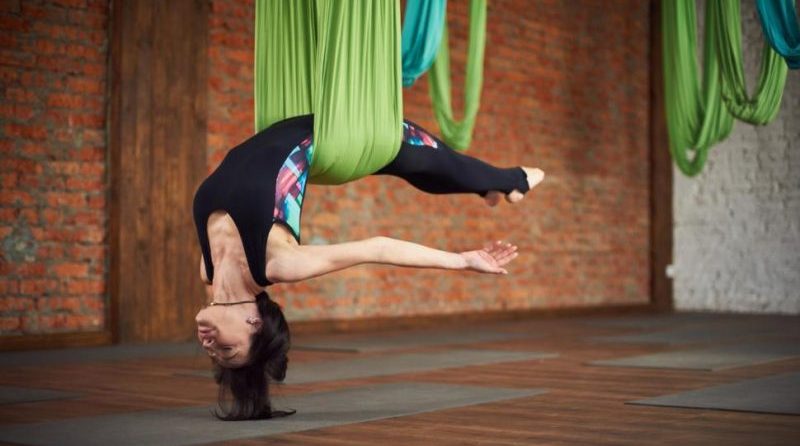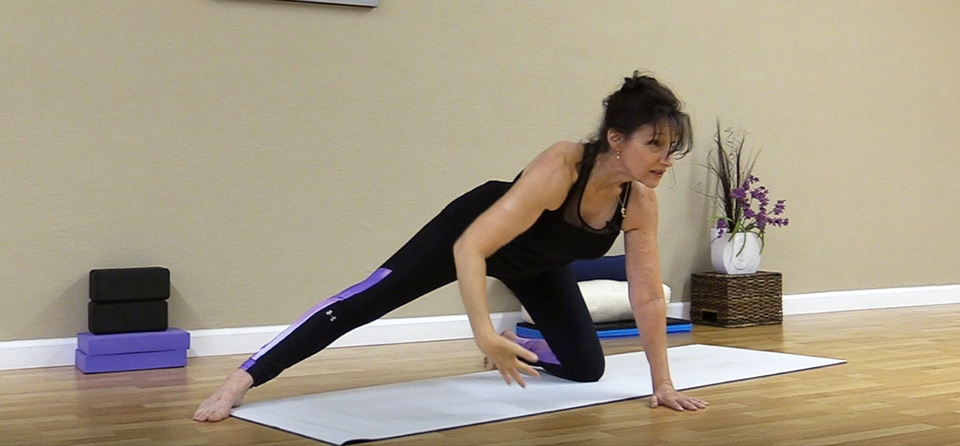Aerial yoga can help decompress your spine and allows you to do deeper yoga poses
Ruben Castaneda, Journalist, Staff Writer, USNews
INSIDE A SPACIOUS exercise studio in Falls Church, Virginia, instructor Susan Lowery leads eight students through a series of yoga moves, like Downward-Facing Dog and the Tree Pose. But Lowery isn’t a yogi, and this isn’t a typical yoga class, where students execute their moves on mats. Instead, Lowery, 47, and the students inside Monarca in Flight Aerial Arts Studio go through their moves while suspended in the air, about 3 feet above the floor, as they’re secured inside long fabric slings (also known as “hammocks”) suspended from the ceiling. They’re practicing aerial yoga.

Photo: Aerial yoga instructor Susan Lowery in an airborne Tree Pose. (credit below: RUBEN CASTANEDA)
To do Tree Pose, for example, Lowery coaches the students to stand securely inside the sling, then balance themselves on one foot while placing the other against the ankle. In a conventional Tree Pose, students stand on a yoga mat and hold their arms overhead, to their sides or place them on their hips while working to maintain their balance. Some people who practice one of the traditional kinds of yoga find it hard to stay in this position for long. However, in aerial yoga, students can use one hand to hold onto the sling, providing stability, which allows a practitioner to hold the pose much longer than he or she would on the floor.
Improved stability isn’t the only attraction of this anti-gravity yoga. “It’s just fun,” says Nicole Fitzpatrick, 41, after her third class with Lowery. “You feel childlike. It’s beautiful.” Fitzpatrick, an epidemiologist/infection prevention nurse, works in the District of Columbia on weekdays on a contract job and is based in Florida. Doing inversions, a maneuver in which the practitioner is suspended in the sling upside-down, has helped decompress her spine, Fitzpatrick says.
“It’s an amazing experience,” says Keanna Joseph, 18, a premed student at Georgetown University. “You feel really versatile and end up doing things in the air you never thought you could do. It’s a lot more freeing than traditional yoga. You feel more in control of your actions, and you get a better stretch.”

A raft of research suggests traditional yoga can provide an array of health benefits, helping practitioners reduce joint and back pain, mitigate stress and improve function. Aerial yoga isn’t a specific type of yoga, such as Kundalini, Ashtanga and Bikram yoga, Lowery says. Rather, it’s a practice that can incorporate different aspects of yoga, like certain poses and meditation, which Lowery includes at the end of her class. Aerial yoga is similar in some regards to gentle yoga, which is also not a specific type of practice. Rather, it’s a slower, gentler version of the centuries-old practice of yoga. Props, like foam wedges, used to support students’ wrists or ankles during certain poses, are used often in gentle yoga.
Similarly, an aerial yoga sling “is just another prop” that allows practitioners to access poses they may not otherwise be able to do and to hold them longer, Lowery says. “Doing aerial yoga increases your range of motion and allows you to go deeper into poses,” she says.
Doing poses inside the hammock or sling (those at Monarca are made of very strong tricot-weave nylon) provides support that can be helpful to beginning yoga practitioners, says Jenny Arrington, a yoga instructor at Northwestern University in Chicago. But using a sling can also be beneficial to people who have more experience with yoga. “Advanced yogis can benefit from aerial yoga because the [sling] can provide more challenge to poses that they may have already mastered,” Arrington says. “For example, a Warrior 2 [pose] may be easy for an advanced yogi, but when done standing in a [sling] suspended above the floor, that same yogi has to recruit a new level of core muscle stabilization and balance without wobbling.”
As with conventional, earthbound yoga, there are a variety of anti-gravity yoga courses, of varying speeds and degrees of difficulty, says Dr. Joanne Wu, who teaches in Rochester, Buffalo. In her medical practice, Wu specializes in physical medicine and rehabilitation. When practiced correctly, aerial yoga can provide some health benefits not easily accessible through traditional yoga, she says. For example, inversions can be quite helpful for decompressing and lengthening the spine, she says. That’s because the act of hanging upside-down could potentially alleviate, at least temporarily, pain from back spasms or scoliosis, a sideways curvature of the spine that can lead to a person having an uneven waist or one hip higher than the other, causing back problems.
If you’re considering trying anti-gravity yoga, experts recommend these five strategies:
1. If you’re not already practicing regular yoga, give it a try first. It would be a good idea to practice traditional yoga before you slide into a sling to do an aerial Downward-Facing Dog, Wu says. “Learn regular yoga and make sure you have some flexibility before trying aerial yoga,” she says. “Doing regular yoga first would be good preparation.”
Dr. Annapoorna Kini, a yoga practitioner as well as the director of the cardiac catheterization laboratory at Mount Sinai Hospital in New York City, agrees. “Yoga in general has amazing physical and mental health benefits, such as improving strength, flexibility, posture and prevent[ing] cartilage and joint breakdown to name a few,” Kini says. “I would suggest practicing regular yoga first to understand the fundamental muscle movements and to learn what’s expected before being suspended in the air.”
2. Ask your health care provider if there’s any reason you shouldn’t try aerial yoga. While the style is safe for most people, there are some individuals with certain health conditions who should stay away from it.
For example, practicing aerial yoga may not be good for people with high blood pressure and uncontrolled diabetes; certain poses, like inversions, can cause your blood pressure to spike until your body gets acclimated to being upside-down, and that quick change could make you susceptible to passing out, Wu says. People with osteoporosis, a condition characterized by soft bones, may also be susceptible to injury. For women who are at a certain point in their pregnancy, some aerial yoga poses could compress major blood vessels, restricting blood flow to the fetus. Before you go airborne, ask your health care provider if aerial yoga is safe for you.
3. Observe and try a variety of aerial yoga classes. Every instructor has a different style and every class is different, Arrington says. Some work at a faster pace; some include meditation, and others don’t. To find the approach that will best help you reach your goals, talk to an array of aerial yoga instructors and observe and participate in different classes to figure out which one suits your needs. “You have to find the right class and the right teacher,” she says.
Look for instructors who keep an eye on everyone in their class and provide individual coaching to students who need it, Lowery advises. A good instructor won’t try to push a practitioner beyond his or her physical limitations, but rather will find ways to make moves accessible.

4. Seek an instructor who’s taught different types of students. Look for an instructor who’s taught a wide range of students, from advanced aerial yoga practitioners to beginners, from young people to older individuals, Wu advises. An instructor who’s worked with a spectrum of students, with different levels of yoga experience and diverse body types and physical abilities, is likely to be able offer you individualized training. “Having an experienced instructor matters,” Wu says.
5. Ask plenty of questions. If you’re considering joining a particular aerial yoga class, it’s a good idea to learn as much about it as possible, Wu says. An instructor experienced in teaching a wide range of people is likely to understand the needs of different practitioners and should be able to help you develop an individualized aerial yoga regimen. Among the questions you can ask an instructor: Do you teach private sessions on a one-on-one basis? How long have you been teaching? Where did you get your training? How often does someone check the rigging of the sling for safety? Based on the responses, you can get a sense of whether the instructor is a good fit for you.
For example, some instructors may not have had formal training in aerial yoga but are self-taught, while others have received certification from different programs, says William Dovidio the co-owner of Aerial Arts of Rochester, where Wu teaches. He suggests looking for an instructor who’s had training in aerial yoga and in body mechanics suitable for same. This gives the instructor the ability to teach students in how to use the correct muscles when practicing aerial yoga, which is helpful in preventing injuries, he says.
“If a student is taught properly, he or she will advance much more quickly and safely than someone who receives improper training,” Dovidio says.










